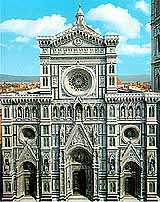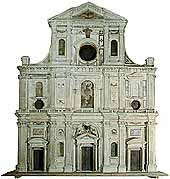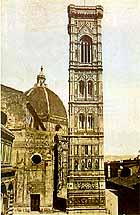
The 19th century facade
The facade of the Cathedral that we can see today is the only decorative part that is not original in the entire square. The facade in red, white and green marble, the statues, rose windows, mosaics and cusps of Gothic inspiration are the fruit of the historic and romantic tastes of the architect, Emilio de Fabris (1808-1883), who carried out the entire revestment between 1876-1886 and managed to design, if not a masterpiece, at least something that created a dignified match between the three buildings of the holy complex: the Cathedral, Giotto's Belltower and the Baptistery. The coats of arms in the lower part are reminders of the Florentine families who helped finance the work. The original facade, conceived by Arnolfo di Cambio and left unfinished at his death (1302), would have been far more precious. Although we can get an idea of what Arnolfo's composition would have been like from the fresco of the Madonna of the Misericordia (1342) in the Museum of the Bigallo, it is shown in far greater detail in a watercolour drawing by Bernardino Poccetti in the Museum of the Opera del Duomo. The drawing was carried out in around 1587, when the decision had already been made to "dismantle" Arnolfo's half-finished facade and substitute it with a more modern one. The court architect Bernardo Buontalenti gave the Medici Grand Duke this idea by including it in the programme intended to modernize the city that had already been started in Vasari's time.

Arnolfo's facade
in a drawing by Poccetti
The Gothic revestment was therefore "taken apart". Some of the marble elements were integrated into the new flooring that was being laid in the interior of Santa Maria del Fiore, while the sculptures were stored, for the most part, inside the Opera del Duomo, later converted into a Museum. They can still be seen today in a room on the ground floor. Five of these statues were carried out by Arnolfo himself: St. Zanobus, St. Reparata (closely resembling Roman statuary), the Madonna and Child (1296) with unusual glass eyes, the Madonna of the Nativity and the interesting Pope Boniface VIII, a solidly constructed sculpture whose partial rigidity seems to emphasize the impression of power and authority of the personage.

Arnolfo di Cambio,
Pope Boniface VIII
The first three statues decorated the lunette above the main entrance conveying the same theme to the Gothic facade as to the modern one: the glorification of the Mother of God to whom the basilica is dedicated. The Madonna of the Nativity, mentioned above, was placed in the lunette above the lefthand entrance and the Madonna Entombed, now in the Berlin Museum, above the one on the right. The Louvre instead owns the statues of St. Lawrence by Giovanni Tedesco (1394 circa) and St. Stephen by Piero di Giovanni Tedesco (1390 circa). The three originals have been replaced by casts. Four niches containing marble statues of the Evangelists, all carried out between 1408 and 1415, were situated on either side of the main doorway.

Arnolfo di Cambio, Madonna of the Nativity
These were of St. Mark by Niccolò di Piero Lamberti, St. Matthew by Bernardo Ciuffagni, St. Luke by Nanni di Banco (like a solemn Roman senator) and St. John by Donatello, the artist's first masterpiece and a powerful anticipator of the Moses by Michelangelo. Commissioned in 1408, the statue took eight years to complete and needed several reminders from the Opera del Duomo, which was even driven to threaten Donatello with economic sanctions unless he made up his mind to finish it. The statue, which in its present position in the museum appears to have too long a torso and a crooked stance, proves the genius of this artist: when placed high up on the facade, it found its perfect proportions. In other words, Donatello invented an "optical correction" that made the figure look its best when looked at from below.

Nanni di Banco,
St. Luke the Evangelist
The room of the Antiphonaries in the Museum contains the various models made for the facade that was supposed to replace the one by Arnolfo. The first competition for its completion was announced in 1491 but the jury put off choosing the winner because they did not find any of the presented projects particularly convincing.

Donatello,
St. John the Evangelist
The Medici Grand Duke tried to resolve the problem again in 1586, egged on by Buontalenti, who took part in the competition with a model of classical Baroque inspiration which luckily was not carried out. Other partecipants in the competition included Giambologna and Don Giovanni Medici (1566-1621), natural son of Cosimo I and Eleonora degli Albizzi and also architect of the Chapel of the Princes in San Lorenzo.

Facade, model by the Academy of Art
A new competition was held in 1633, this time won by the project by the Academy of Fine Arts and whose execution was entrusted to the Opera's architect, Gherardo Silvani: the first stone was laid in 1636 but two years later everything was suspended because of the fierce criticism of the project by Silvani himself, who had also unsuccessfully presented a model of his own in the competition. Before De Fabris, several architects had, in the 19th century, attempted to produce an acceptable design, among them Giovanni Silvestri (1822), Nicola Matas (1842), who had previously carried out the facade of Santa Croce, and Gian Giorgio Muller (1843-44).

The facade without its revestment.
